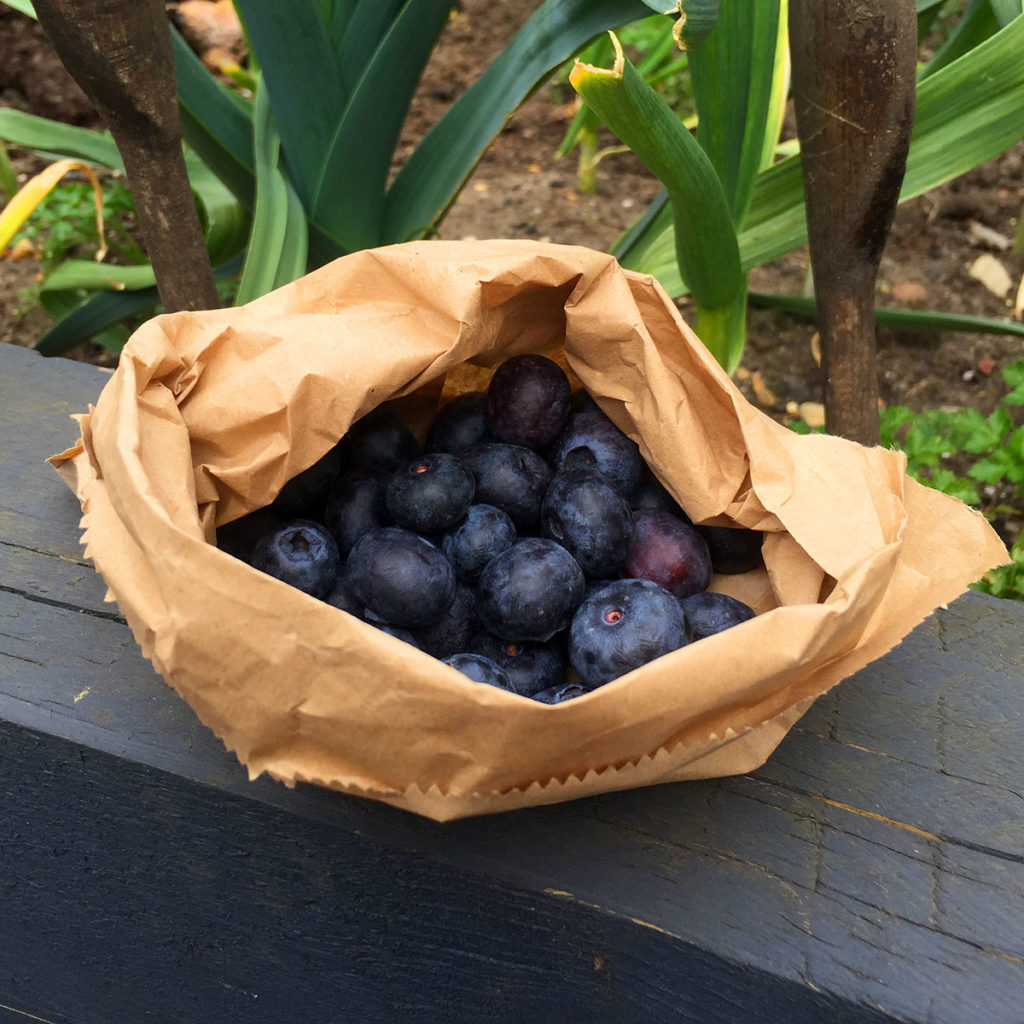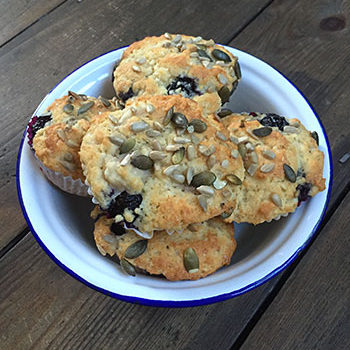Heavenly Gluten-Free Blueberry Muffins Recipe
If you’re looking for a delightful gluten-free treat that’s perfect for breakfast or a quick snack, these gluten-free blueberry muffins are just the ticket!
I am very lucky that I have a big blueberry bush in my garden so come the summer months I have fresh, juicy blueberries a plenty.
As a coeliac myself, I know how challenging it can be to find tasty baked goods that are safe to eat.
That’s why I’ve perfected this recipe to bring you muffins that are not only gluten-free but also moist, flavourful, and utterly scrumptious.

Table of Contents
What you’ll love about this recipe
They’re Light, Fluffy, and Utterly Moreish
Gluten-free blueberry muffins can be just as light and fluffy as their traditional counterparts, so you won’t feel like you’re missing out one bit. They’re perfect for breakfast, a midday treat, or whenever you fancy a little pick-me-up.
A Burst of Juicy Sweetness in Every Bite
Blueberries bring a lovely pop of sweetness and a bit of tang, making each mouthful a delight. The berries keep the muffins moist and add a gorgeous, natural flavour that’s hard to resist.
Ideal for Everyone—Not Just the Gluten-Free Crowd
You don’t need to be coeliac or gluten intolerant to enjoy these muffins. They’re so tasty that everyone will want one, whether they’re following a gluten-free diet or not.
Healthier Ingredients, Guilt-Free Indulgence
Many gluten-free blueberry muffin recipes use wholesome ingredients like almond flour, oat flour, or buckwheat, and are often lower in sugar. That means you can enjoy a treat that’s a bit better for you, without sacrificing flavour.
Perfect for Busy Days and On-the-Go Snacking
Gluten-free blueberry muffins are a lifesaver when you’re in a rush. Pop one in your bag for a quick breakfast or a snack during the day—they’re just the thing for busy mornings or when you need something tasty on the move.
So go on, treat yourself to a gluten-free blueberry muffin. They’re proof that you can have your cake (well, muffin) and eat it—even without the gluten!
Ingredients
- 125g Gluten-free self-raising flour
- 1 tsp Gluten-free baking powder
- 50g Brown sugar
- 50g Blueberries
- 60ml Vegetable oil
- 1 mashed banana
- 1 medium egg
- 50 ml milk
Instructions
- Pre-heat the oven to 180C/Gas 4/ 350F
- In a bowl mix together the flour, baking powder, sugar and blueberries.
- In a jug beat the egg, stir in the milk and oil.
- Mash the banana and add t the flour.
- Pour the wet ingredients into the flour mixture and stir gently.
- Divide the batter between the muffin cases and bake them in the oven for 15-20 minutes.
- Allow the muffins to cool on a wire cooling rack, then eat.


What to serve with gluten-free blueberry muffins
A cup of Tea or Coffee
Gluten-free blueberry muffins are perfect companions to a steaming cuppa. Whether you prefer a classic English breakfast tea, Earl Grey, or a strong coffee, the combination is simply smashing for a morning or afternoon treat.
Fresh Fruit or a Fruit Salad
Serve your muffins alongside a bowl of fresh seasonal fruit or a colourful fruit salad. The juicy freshness pairs beautifully with the soft, sweet muffins and adds an extra boost of vitamins.
Greek Yogurt or Dairy-Free Yogurt with Honey
A spoonful of creamy Greek yogurt (or a dairy-free alternative) drizzled with a little honey complements the muffins nicely, adding protein and a tangy balance to the sweetness.
A Nut Butter Spread
For a bit of extra indulgence and protein, try spreading some almond butter, peanut butter, or cashew butter on your muffin. It’s a delicious way to add a nutty flavour and keep you fuller for longer.
So, whether it’s a simple buttered muffin with tea or a more substantial breakfast plate, these pairings will elevate your gluten-free blueberry muffin experience beautifully. Cheers!


Gluten-Free Blueberry Muffins Recipe
Equipment
- Fork
- Measuring Jug
- Muffin cases
- Muffin Tray
Ingredients
- 125 g Gluten-free self-raising flour (4.5 ounces)
- 1 tsp Gluten-free baking powder
- 50 g Brown sugar (2 ounces)
- 50 g Blueberries (2 ounces)
- 60 ml Vegetable oil (2 fl oz)
- 1 Mashed banana
- 1 Medium egg
- 50 ml Milk (2 fl oz)
Instructions
- Preheat the oven to 180℃ /Gas 4/ 350F.
- In a bowl mix together the flour, baking powder, sugar and blueberries.
- In a jug beat an egg, stir in the milk and oil.
- Mash a banana and add that to the flour for extra sweetness.
- Pour the wet ingredients into the flour mixture and gently stir together.
- Divide the mixture between 7 muffin cases and bake them in the oven for 15-20 minutes.
- Take them out of the oven and place them onto a cooling rack. You can eat them as soon as they are cool enough!
Nutrition
If you enjoyed my gluten-free blueberry muffin recipe, then check these out 👇
- Gluten-free breakfast muffins
- Gluten-free banana muffins
- Gluten-free apple muffins
- Gluten-free chocolate muffins
- Gluten-Free pancakes
Gluten-free Blueberry Muffin Tips
Use the Right Flour Blend
Gluten-free baking flour blends (like rice flour combined with tapioca or almond flour) work best because they mimic the texture of wheat flour. Some recipes also add xanthan gum or guar gum to help bind the batter and give the muffins a lovely crumb.
Be Gentle with the Blueberries
When folding in your blueberries, do it gently and slowly to avoid bursting the berries and turning your batter purple. Use a wooden spoon or spatula to carefully fold them in at the end.
Don’t Overmix the Batter
Mix your wet and dry ingredients until just combined. Overmixing can make muffins tough or dense, especially in gluten-free baking where the texture is more delicate.
Add Moisture and Fat
Ingredients like eggs, melted butter or coconut oil, and buttermilk (or dairy-free milk alternatives) add moisture and richness, helping your muffins stay soft and tender.
Watch Your Baking Time and Temperature
Bake at around 175-180°C (350°F) for 15-25 minutes, depending on your oven and muffin size. Keep an eye on them and test with a skewer or toothpick – it should come out clean when they’re done. Also, allow muffins to cool completely on a wire rack, as gluten-free muffins firm up as they cool.
Bonus tip: For a lovely flavour twist, add a little lemon zest or a sprinkle of sliced almonds on top before baking to give your muffins an extra zing and crunch.
Frequently Asked Questions
Can I use frozen blueberries instead of fresh?
Yes, absolutely! You can use frozen blueberries straight from the freezer—no need to defrost them first. Just toss them in a little gluten-free flour before folding into the batter to prevent them from sinking or bleeding too much colour.
What gluten-free flour blend works best for muffins?
A good-quality gluten-free all-purpose flour blend that includes xanthan gum or guar gum works best. These gums help bind the muffins and give a nice texture similar to traditional flour. Some popular brands include Bob’s Red Mill, Doves Farm and King Arthur Flour Blends.
Can I make these muffins dairy-free or vegan?
Yes! You can substitute dairy milk with plant-based milks like almond or oat milk, and use dairy-free butter or coconut oil. For vegan muffins, replace eggs with flax eggs or commercial egg replacers. Many recipes include these substitutions and still produce soft, tasty muffins.
How do I get tall, fluffy muffin tops?
Two tips: chill the batter for at least 20 minutes before baking to hydrate the flour and develop flavour, and bake initially at a higher temperature (around 220°C/425°F) for 5-7 minutes, then reduce to 175°C/350°F to finish baking. This helps create those lovely domed tops.
How should I store gluten-free blueberry muffins?
Store completely cooled muffins in an airtight container at room temperature for up to 1-2 days. For longer storage, wrap individually and freeze. To reheat, microwave for 20-30 seconds or warm in the oven until heated through
Share the love!
Related recipes 🔗
Becky Terrell ✍️
Comments
There are 5 comments on this post. Leave a comment 👇




[…] for Starbucks Lime Coconut Bars too! If you are on a gluten free diet, you can check out this gluten free blueberry muffins […]
Packed with fruit and so fluffy, they didn’t last a day in our house.
Juicy bursts in every bite—I always bake extra for freezing (though they rarely last that long).
Bursting with juicy berries, these are now part of my weekend routine.
These muffins are bursting with juicy blueberries and have a delightful texture that makes for a perfect breakfast treat.